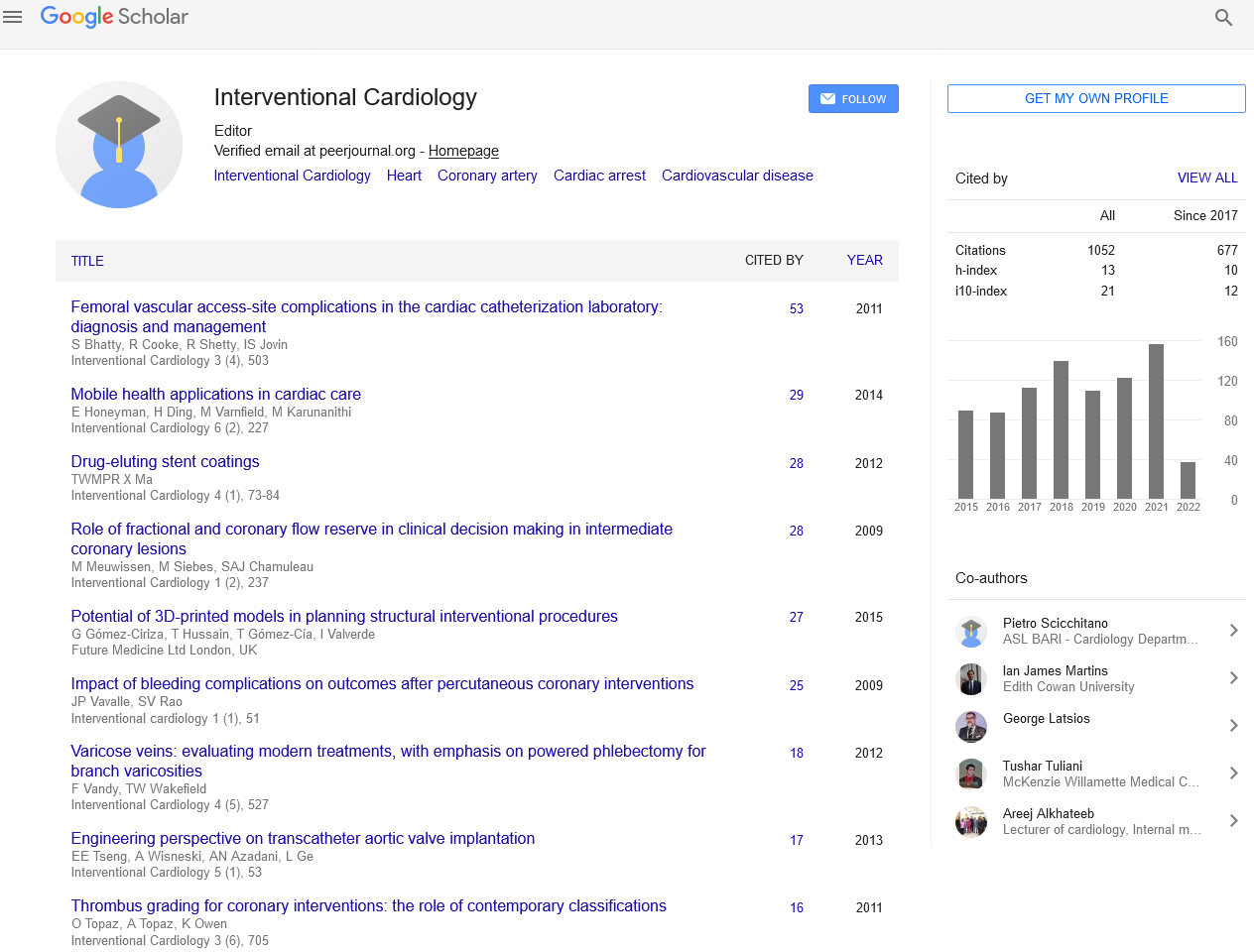Letter to Editor - Interventional Cardiology (2017) Volume 9, Issue 4
Positive and negative false estimates of serum creatinine
- Corresponding Author:
- Prabhat K Nigam
Department of Cardiology, King George’s Medical University
UP, Lucknow 226004, India
Tel: +919235775577
E-mail: p_nigam1@yahoo.com
Submitted: June 21, 2017; Accepted: July 12, 2017; Published online: July 19, 2017
Abstract
Accurate and precise measurement of serum creatinine is very important for assessment of kidney function. However, false estimates of serum creatinine have been found due to interference by both exogenous and endogenous substances which have been attributed to factors such as decreased or inhibited tubular secretion of creatinine, interference with serum creatinine assays and increased production of creatinine. Several drugs cause positive and negative interference through these mechanisms resulting in false positive and negative estimates of serum creatinine which may affect glomerular filtration rate (GFR) calculation also. Endogenous substances also affect the creatinine assay systems resulting in false estimate of serum creatinine concentration. Therefore, the awareness about the drug-induced or endogenous substance-induced false estimates of serum creatinine and preanalytical errors in blood sampling is important. Some remedial measures to avoid these interferences are: (i) avoiding blood draws from indwelling catheter, (ii) giving preference to fasting blood specimen and (iii) selecting the suitable analytical method for creatinine estimation (based on the information about the drugs being given to the concerned patient).
Keywords
False, Creatinine
Introduction
Glomerular filtration rate(GFR) is considered as the best indicator of kidney function. An inverse relationship has been found between serum creatinine concentration and GFR and therefore, an elevated level of serum creatinine reflects a decrease in GFR and reduced kidney function. Moreover, GFR is generally calculated using equations which incorporate serum creatinine concentration. Therefore, the accurate measurement of serum creatinine is of utmost importance. However, false estimates (positive and negative) of serum creatinine do occur. This false estimate of serum creatinine may be due to interference by exogenous as well as endogenous substances and has been attributed to factors such as (1) decreased or inhibited tubular secretion of creatinine (normally about 15% of urinary creatinine comes from its secretion in the proximal tubules), (2) interference with serum creatinine assays and (3) increased production of creatinine [1].
Exogenous Substances
There are many drugs, which result in elevation of serum creatinine concentration without affecting GFR (Table 1). Therefore, it is very important to know how these drugs result in false elevation (overestimation) or sometimes false decline (underestimation) in serum creatinine levels to interpret the laboratory results correctly for diagnosis of renal function/disease. Perusal of Table 1 shows that drugs like cimetidine, ranitidine, famotidine, trimethoprim, pyrimethamine, salicylates, cobicistat and calcitriol inhibit tubular secretion of creatinine resulting in increased levels of serum creatinine [2]. Cimetidine, trimethoprim and salicylate therapy alter tubular secretion and result in increase in serum creatinine levels by 20%, 15-35% and 35-40% respectively [3]. However, this interference with tubular secretion of creatinine is reversible as withdrawal of these drugs brought the creatinine levels to preexisting ones. The increase in serum creatinine by these drugs was usually within the normal range and hence has no clinical consequences but this increase could be more striking in patients with renal impairment, particularly when long-standing therapy is needed [2].
| Inhibition of tubular secretion of creatinine | Interference with creatinine assay | ||
|---|---|---|---|
| Drugs/endogenous substances | Enzymatic | Jaffe’s | |
| Cimetidine (+) Famotidine (+) Ranitidine (+) Trimethoprim (+) Pyrimethamine (+) Salicylates (+) Cobicistat (+) Calcitriol (+) |
Cefoxitin Cephalothin Cefpirom Cephazolin Lidocaine Flucytosine Dopamine Dobutamine Acetohexamide Furosemide Aspirin Acetoaminophen Metamizole Streptomycin Ethamsylate Calcium dobesilate S-aminolevulinic acid Phenacemide Bilirubin Glucose Haemoglobin Albumin Pyruvate Creatine Acetoacetate Haemoglobin F B-hydroxy butyrate Lipemia proteins |
NS NS NS NS (+) (+) (-) (-) NK NS (-) (-) (-) NK (-) (-) NS NK (-) (±) (-) NS NS NS NS NS (+) (-) (±) |
(+) (±) (+) (+) (±) NS (-) (±) (+) (-) (+) (+) (+) (+) NK NK (+) (+) (-) (+) (+) (±) (+) (+) (+) (-) (±) (+) (±) |
Table 1: Drugs/endogenous substances causing false estimates of serum creatinine (based on references mentioned in the text).
Fenofibrates-induced elevation of serum creatinine has been reported and fenofibrate has been postulated to alter intrarenal haemodynamics [4] as well as shown to cause tubular toxicity and increased production of creatinine [5]. However, the increase in serum creatinine due to fenofibrate therapy was found to be reversible after fenofibrate withdrawal.
Corticosteroides have been reported to increase GFR nonspecifically [6] but nevertheless the creatinine concentration increased by 10% [7]. This increase in creatinine is attributed to the catabolic state with protein degeneration and loss of muscle tissue induced by the steroid treatment [2]. The steroid induced diabetic state is also presumed to be the cause of increased serum creatinine in patients on steroids [8].
The list of drugs causing interference in creatinine assays is quite long (Table 1). The two most popular routine methods of creatinine estimation are Jaffe’s kinetic method and enzymatic methods. Though the influence of interfering substances has been found to be less frequent with enzymatic methods [9] yet the Jaffe’s method has the benefit of cost effectiveness.
The drugs of cephalosporin group generally cause positive interference or positive bias (over estimation) with Jaffe’s method. However, the enzymatic methods of creatinine estimation resist this interference [3,9,10]. Lidocaine gives positive interference with enzymatic assays but less interference has been reported with Jaffe’s method [3,9,11]. Fluocytosine gives falsely elevated creatinine values due to interference in enzymatic methods but not in Jaffe’s method [12]. Therefore, Jaffe’s based analytical systems should be used to analyze serum creatinine in patients receiving lidocaine or fluocytosine therapy [3]. On the other hand dopamine and dobutamine interfere negatively in both Jaffe’s [10] and enzymatic methods [10,13]. However, Greenberg et al. [9] did not find any interference by dopamine in both the methods but dobutamine caused positive interference with Jaffe’s method but negative interference with enzymatic methods. Acetohexamide also gives falsely elevated serum creatinine in Jaffe’s method [14]. Furosemide interferes negatively in Jaffe’s method giving undetectable serum creatinine, which were detectable by enzymatic method [15].
There are some drugs, such as aspirin, acetoaminophen and metamizole, which interfere positively in Jaffe’s method but negatively with enzymatic methods (Table 1). Streptomycin interferes positively with Jaffe’s method but only in high doses (above therapeutic dose) [16]. Therefore, the selection of suitable method for creatinine estimation is important. Other drugs interfering in creatinine estimation are ethamsylate, calcium dobesilate and 5-aminolevulinic acid. Phenacemide also gives false positive estimates of serum creatinine but the mechanism of this effect is not clear [2,3].
Improper blood sampling may also cause drug interference. Saenger et al. [13] reported the negative interference by catecholamines in blood samples obtained from indwelling catheters whereas no interference was noted in peripheral blood samples. The reversible adherence of catecholamines to indwelling catheter has been suggested to be the cause of this interference as has been found with cyclosporins [17]. Therefore, blood draws from indwelling catheter should be avoided. Further, the test ordering form should contain the information about the drugs being given to the patient so that the analyst could select the suitable method for creatinine estimation.
Endogenous Substances
Table 1 shows the endogenous substances interfering in creatinine assay. Among the endogenous substances causing positive interference in Jaffe’s methods, the most important ones are glucose and acetoacetate. The extent of this positive interference is quite less in enzymatic methods. However, no general conclusions regarding Jaffe’s or enzymatic technologies can be drawn [9]. Haemoglobin and lipemia have been shown to interfere positively in Jaffe’s method but negatively with enzymatic assays. The haemoglobin interference can be easily avoided by not using haemolysed sera.
Bilirubin is a negative interferent in both enzymatic and Jaffe’s methods. This results in underestimation of serum creatinine in icteric sera. Several modifications in the assay systems have been suggested to overcome this negative interference due to bilirubin [8,18]. The manufacturers of reagent kits generally do not mention specifically about the quantitative effect of interferents. Hence it is imperative for the analysts to check every kit for the extent of interference before use [19].
Another source of false estimate of serum creatinine is increased production due to increased intake of cooked meat. The creatine present in meat is converted into creatinine on cooking which is absorbed causing a significant increase in serum creatinine [20]. Therefore, fasting blood should be preferred for creatinine estimation and GFR calculation.
Conclusions
The false estimates of serum creatinine due to endogenous and exogenous substances are well known. Therefore, the awareness about the drug-induced or endogenous substances-induced false estimates of serum creatinine is important to interpret the laboratory results correctly for diagnosis of renal function/disease. Some remedial measures to avoid these interferences are: (i) avoiding blood draws from indwelling catheter, (ii) giving preference to fasting blood specimen and (iii) selecting the suitable analytical method for creatinine estimation (based on the information about the drugs being given to the concerned patient).
References
- Samra M, Abcar AC. False estimates of elevated creatinine. Perm. J. 16: 51-52 (2012).
- Andreev E, Koopman M, Arisz L. A rise in plasma creatinine that is not a sign of renal failure: which drugs can be responsible. J. Intern. Med. 246: 247-252 (1999).
- Ducharme MP, Smythe M, Strohs G. Drug induced alterations in serum creatinine concentrations. Ann. Pharmacotherapy. 27: 622-633 (1993).
- Browsers N, Knoop C, Antoine M, Tielemans C, Abramowitz D. Fibrate-induced increase in blood urea and creatinine: Is gemfibrozil the only innocuous agent? Nephrol. Dial. Transplant. 15: 1993-1999 (2000).
- Angeles C, Lane BP, Miller F, Nord EP. Fenofibrate-associated reversible acute allograft dysfunction in 3 renal transplant recipients:biopsy evidence of tubular toxicity. Am. J. Kidney. Dis. 44: 543-550 (2004).
- George CRP. Non-specific enhancement of glomerular filtration by corticosteroids. Lancet. ii: 728-729 (1974).
- van Acker BAC, Prummel MF, Weber JA, Wiersinga WM, Arisz L. Effect of Prednisone on renal function in man. Nephron. 65: 254-259 (1993).
- Bowers LD, Wong ET. Kinetic serum creatinine assays. II. A critical evaluation and review. Clin. Chem. 26: 555-561 (1980).
- Greenberg N, Roberts WL, Bachmann LM, et al. Specificity characteristics of 7 commercial creatinine measurement procedures by enzymatic and Jaffe method principles. Clin. Chem. 58: 391-401 (2012).
- Peake M, Whiting M. Measurement of serum creatinine-current status and future goals. Clin. Biochemist. Rev. 27: 173-884 (2006).
- Splinler SA, Anderson BD, Kindwall KE. Lidocaine interference with Ekta Chem analyzer determination of serum creatinine concentration. Clin. Pharm. 8: 659-663 (1989).
- Mitchell RT, Marshall LH, Lefkowitz LB, Stratton CW. Falsely elevated serum creatinine levels secondary to the presence of 5-fluorocytosine. Am. J. Clin. Pathol. 84: 251-253 (1985).
- Saenger AK, Lockwood C, Snozek CL, et al. Catecholamine interference in enzymatic creatinine assays. Clin. Chem. 55: 1732-1736 (2009).
- Roach NA, Kroll MH, Elin RJ. Interference by sulfonylurea drugs with Jaffe method for creatinine. Clin. Chem. Acta. 51: 301-305 (1985).
- Murphy JL, Hurt TL, Griswold WR, et al. Interference with creatinine concentration measurement by high dose furosemide infusion. Crit. Care. Med. 17: 889-890 (1989).
- Syal K, Banerjee D, Srinivasan A. Creatinine estimation and interference. Ind. J. Clin. Biochem. 28: 210-211 (2013).
- Lorenz RB, Garette N, Turk JW, Scott MG. Problems with therapeutic monitoring of cyclosporine using silicone central venous line samples. Transplantation. 52: 1109-1110 (1991).
- Srisawasdi P, Chaichajarernkul U, Teerakanjana N, Vanavanan S, Kroll MH. Exogenous interference with Jaffe creatinine assays: addition of sodium dodecyl sulfate to reagent eliminates bilirubin and toal protein interference with Jaffe methods. J. Clin. Lab. Anals. 24: 123-133 (2010).
- Nigam PK. Bilirubin interference in serum creatinine estimation by Jaffe’s kinetic method and its rectification in three different kits. Ind. J. Clin. Biochem. 31: 237-239 (2016).
- Nair S, O’Brien SV, Hayden K, et al. Effect of a cooked meat meal on serum creatinine and estimated glomerular filtration rate in diabetes-related kidney disease. Diabetes. Care. 37: 483-487 (2014).


